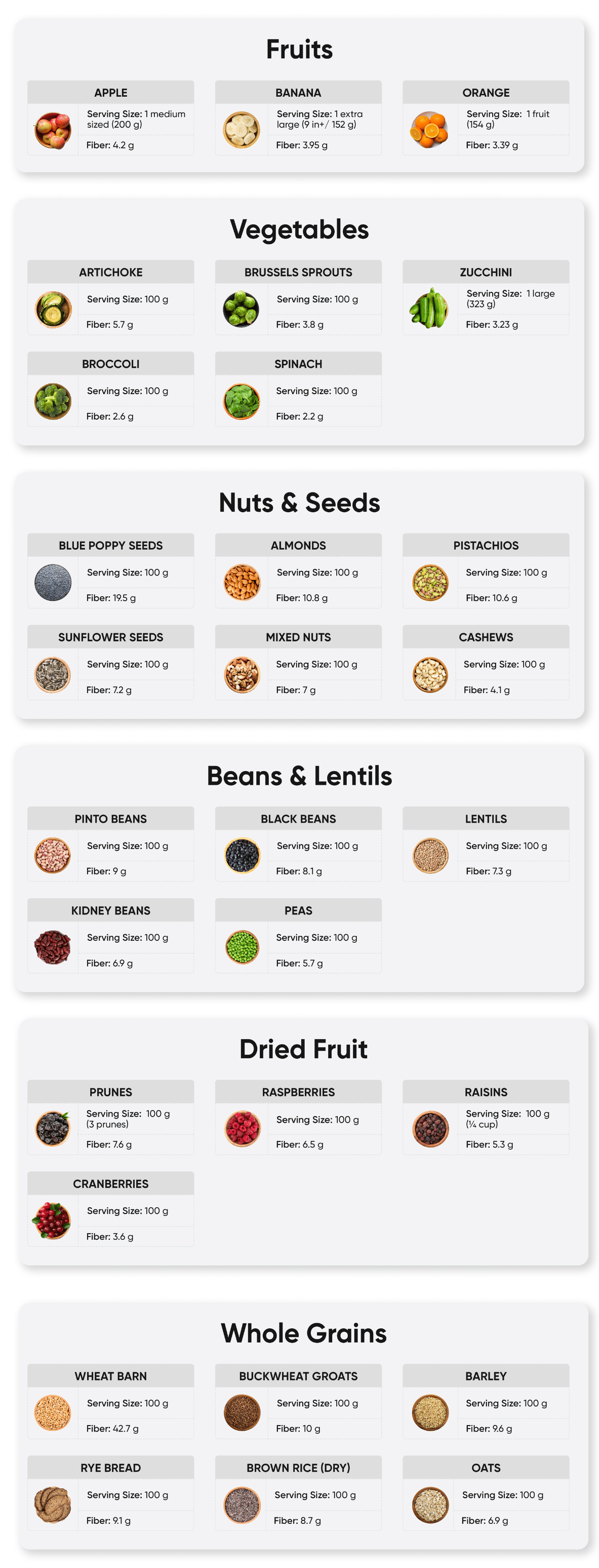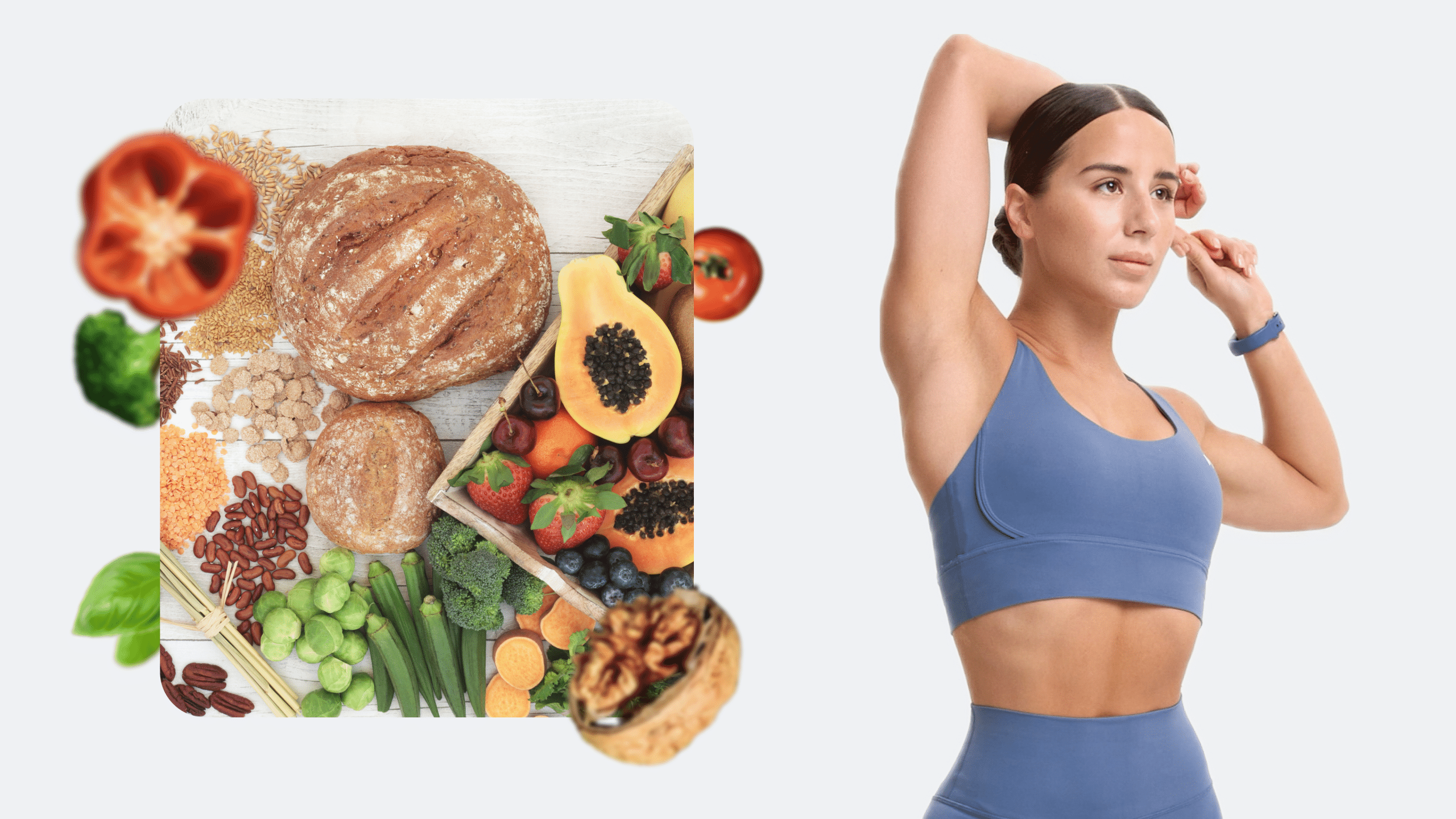If you’ve ever eaten a salad and felt like the only reason it was good for you is that it would help you lose weight, or because your doctor has told you to reduce your intake of cholesterol and fat but all the meatless dishes they suggest just don’t hit the spot, then this article is for you.
We’re going to cover everything from what dietary fiber actually is (and why those salads are so darn healthy), how much we need every day (more than most people think!), as well as some quick hacks to get more dietary fiber into any diet, even if that means eating more fruits and vegetables! And finally, we’ll talk about some side effects – both positive and negative – of eating dietary fiber and some tips for increasing your intake.
What is Dietary Fiber?
Dietary fiber, also known as roughage or bulk, is the part of plant foods that are not broken down by digestive enzymes (11). These fibers can’t be absorbed by your body but they still provide many health benefits. There are two types of dietary fibers: insoluble and soluble.
Insoluble fibers don’t dissolve in water and tend to produce a bulking effect when eaten which helps move food through your intestines more quickly for easier elimination (examples include wheat bran, whole-wheat flour) (37).
Soluble fibers do dissolve in water and form a gel-like material in the stomach which slows down digestion and therefore offers protection from conditions such as high blood sugar, diverticulosis, and weight gain (29). Soluble fibers are found in foods such as oats, peas, beans, apples, citrus fruits, carrots, and barley.
How Much Fiber Do You Need Per Day?
The amount of dietary fiber you need per day varies depending on your unique circumstances. Like most nutritional guidelines, everyone has a different “sweet spot” and you should check in with your doctor to figure out what it is for you.
Most health governing bodies recommend an average daily allowance of 20-38 grams per day based on age and gender, although this number can be much higher if necessary (and even lower when not) (9).
Generally, the more active you are, the more dietary fiber your body will need to help keep things moving smoothly.
In general, most health experts agree that no matter how often you eat or what types of foods you prefer, if it’s a plant-based food then there is most likely some amount of dietary fiber in it. So, to get more fiber in your diet you can start by looking into more plant-based meals.
Betterme will keep you laser-focused on your weight loss journey! Nutrient-packed meal plans, fat-blasting workouts, galvanizing challenges and much more. Try using the app and see for yourself!
What Foods Have Fiber?
Here are the best choices for a high-fiber diet:
Fruits
Not only are these healthy in general but they also contain a good amount of dietary fibers (16). Try adding one or two fruits to your daily meals for better health overall plus the fiber benefits!
- Apple – 4.2 grams
- Banana (extra large) – 3.95 grams
- Orange – 3.39 grams
Vegetables
During the cooking process many water-soluble fibers are removed from foods like vegetables which is why it’s best to eat them raw for maximum fiber content but if you do cook them it’s still great. As far as specific veggies go:
- Artichoke – 5.7 grams per 100 gram serving
- Brussels sprouts – 3.8 grams per 100 gram serving
- Spinach – 2.2 grams per 100 gram serving
- Broccoli – 2.6g per 100 gram serving
- Zucchini (large) – 3.2 grams per 1 zucchini
Nuts And Seeds
Although high in calories, nuts and seeds provide essential nutrients plus good amounts of dietary fibers (24). Fiber-rich options include:
- Pistachios – 10 grams per 100 gram serving (about 1/2 cup)
- Almonds – 10.8 grams per 100 gram serving (about 1/4 cup)
- Cashews – 4.1 grams per 100 gram serving (about 1/4 cup)
- Mixed nuts – 7 grams per 100 gram serving (about 1/4 cup)
- Sunflower seeds – 7.2 grams per 100 gram serving (about 2 tablespoons)
Beans And Lentils
These are excellent sources of fiber since they contain both soluble and insoluble fibers in addition to plant protein which is another benefit (33). Legumes are very versatile so you should be able to find several ways to add them into your daily meals without getting tired of them. Some examples of beans, other legumes and lentils and their fiber content are as follows
- Peas – 5.7 g per 100 g serving
- Kidney beans – 6.9 g per 100 g serving
- Pinto beans – 9 g per 100 g serving
- Black beans – 8.1 g per 100 g serving
- Lentils – 7.3 g per 100 g serving
Whole Grains
Whole grains tend to be better choices than refined grains because the refining process removes the fiber and many essential nutrients like magnesium and B vitamins. Whole grains are also rich in antioxidants that can prevent damage to the body’s cells which is another step towards better health (36).
Dried Fruit
When dried, fruit fibers are more concentrated, but so are the calories. For instance:
- Cranberries – 3.6 grams per 100 gram serving
- Raspberry – 6.5 grams per 100 gram serving (about 2 medium plums)
- Prunes – 7.6 grams per 100 gram serving (about 3 prunes)
- Raisins – 5.3 grams of dietary fiber per 100 gram serving (about 1/4 cup)
Read more: 7-Day Weight Loss Low-Carb Diet: Choose High-Protein, High-Fiber, or Ultra-Low-Carb
Fiber Supplements
Nowadays there are several supplements on the market containing healthy doses of dietary fiber as well as other ingredients like Vitamin C and lecithin that may help improve your health overall (14). Some of the top options to look for include psyllium husk, glucomannan fiber, acacia gum, oat bran fiber, and pectin which are all excellent sources of dietary fibers that can aid in your daily diet.
High-Fiber Foods Chart
It can be hard to keep track of foods high in soluble and insoluble fibers. Below is a high fiber low-calorie foods chart you can use to know which meals to have:

Benefits Of Consuming More Dietary Fibers
Plenty of studies and scientific journals have found multiple benefits for those who increase daily consumption of dietary fibers:
Lower Cholesterol Levels
It is well established that dietary fiber can lower cholesterol levels, particularly LDL (bad) cholesterol (8). One study found out of all the fiber-rich foods tested, oats had the greatest effect on lowering low-density lipoprotein (LDL) cholesterol (27).
Lower Blood Sugar
As mentioned above, soluble fibers slow down digestion and form a gel that traps sugars in after they’ve been consumed. This helps insulin maintain more steady glucose levels throughout the day which prevents spikes and crashes in energy. Studies have also shown soluble fiber to be helpful for individuals suffering from diabetes, especially type 2 (12).
Weight Loss
Bulkier foods tend to help people feel full faster so when you eat more dietary fibers your stomach stays fuller for longer and you’ll naturally consume fewer calories (10).
Decreased Risk of Diverticulosis
Studies have found a strong connection between increased dietary fiber intake and decreased risk of developing the painful condition known as diverticulosis (13).
This condition occurs when small pouches form in the intestine and get inflamed. One way to avoid this is to eat foods high in soluble fiber which forms a gel that coats intestinal walls preventing inflammation from occurring.
Improved Digestion
Soluble fibers increase the water content in stools which makes them softer and easier to pass through your digestive system without feeling constipated or bloated. On the other hand, insoluble fibers speed up the passage of food through your system, which can help reduce constipation (32).
BetterMe app will kick you out of the mental funk, shake off your extra weight, rid you off your energy-zapping habits, and help you sculpt the body of your dreams. Intrigued? Hurry up and change your life for the better!
Side Effects of Consuming Too Much Dietary Fiber
While getting plenty of dietary fiber has many health advantages, it can also have some negative side effects if you consume too much at once or don’t drink enough water while eating your dietary fiber.
Constipation
This condition occurs when bulky foods cause stool to become hard and dry which makes it difficult for bowel muscles to expel them. Insoluble fibers will usually help with constipation but if you find yourself dealing with the issue regularly then it might be because you are getting too much fiber and/or not enough water (21).
Diarrhea
This condition can occur when you abruptly eat more fiber than your body is used to and it irritates your GI tract, causing peristalsis. Too much of these fibers at once can cause stool to mix poorly with water which leads to diarrhea.
Bloating
This is caused when you eat more dietary fibers than usual and your body doesn’t process them properly. The result? A bloated feeling which can be uncomfortable and painful (17)
Gastrointestinal Obstruction
If you increase your daily dietary fiber intake too quickly or consume more than what you’re used to, especially without drinking more fluid, the result might be an obstruction in the digestive tract which is very dangerous and potentially life-threatening.
What To Do If You’ve Had Too Many High-Fiber Foods
Increase Intake Over Time
One of the best things about dietary fiber is that your body gets used to it over time and will adjust how much it needs so there really isn’t such thing as “too much” even in extreme cases, but if you do find yourself dealing with negative side effects you should stop eating so many high-fiber foods and gradually increase your fiber intake over weeks or months.
Drink More Water
Your body needs enough water to process dietary fibers so make sure you’re drinking at least half your weight in ounces each day. Drinking enough water is important for proper functioning of all organs within the body (34).
Avoid Bloating Foods
Dietary fibers are helpful for preventing bloating but some foods can make it worse. For example, beans contain the soluble fiber which forms a gel that helps eliminate gas build-up but they also tend to cause more problems since many people are intolerant of the sugars found within them. Try limiting bean intake until your system adapts then slowly introduce them back into your diet.
Review Your Fiber Sources
Insoluble fibers speed up the passage of food through your digestive tract while soluble ones create a gel that slows things down (37). If you’re having trouble with bloating, gas or diarrhea then start by reducing your insoluble fiber intake since this is what speeds up digestion, and maybe increase your soluble fiber intake.
If you’re having constipation you might want to increase your intake of both types of fiber – insoluble fiber can help form bulk and promote movement while soluble fiber combined with water may make the stool softer and easier to pass. If you’re dealing with both problems then start by slowly reducing the amount of fiber in your diet and make sure to drink at least half your weight in ounces of fluid each day until things improve.
Read more: Your Guide to High Fiber Breakfasts For Sustained Energy
The Bottom Line
Whether you’re simply trying to increase the amount of dietary fiber you’re getting or looking to try something new, it really is an essential part of any healthy diet plus boosts overall health too! If you think you’re not getting enough then try increasing your intake by adding more fruits & veggies into meals throughout the day as well as supplementing with other great options mentioned above. Be sure to drink plenty of water when taking dietary fiber supplements too since they can cause stomach discomfort if not enough water is consumed.
DISCLAIMER:
This article is intended for general informational purposes only and does not serve to address individual circumstances. It is not a substitute for professional advice or help and should not be relied on for making any kind of decision-making. Any action taken as a direct or indirect result of the information in this article is entirely at your own risk and is your sole responsibility.
BetterMe, its content staff, and its medical advisors accept no responsibility for inaccuracies, errors, misstatements, inconsistencies, or omissions and specifically disclaim any liability, loss or risk, personal, professional or otherwise, which may be incurred as a consequence, directly or indirectly, of the use and/or application of any content.
You should always seek the advice of your physician or other qualified health provider with any questions you may have regarding a medical condition or your specific situation. Never disregard professional medical advice or delay seeking it because of BetterMe content. If you suspect or think you may have a medical emergency, call your doctor.
SOURCES
- Apple, raw (2022, fdc.nal.usda.gov)
- Artichoke, fresh, cooked, no added fat (2022, fdc.nal.usda.gov)
- Bananas, raw (2019, fdc.nal.usda.gov)
- Beans, black, mature seeds, cooked, boiled, without salt (2019, fdc.nal.usda.gov)
- Beans, pinto, mature seeds, cooked, boiled, without salt (2019, fdc.nal.usda.gov)
- Broccoli, raw (2019, fdc.nal.usda.gov)
- Brussels sprouts, NS as to form, cooked (2022, fdc.nal.usda.gov)
- Cholesterol-lowering effects of dietary fiber: a meta-analysis (1999, pubmed.ncbi.nlm.nih.gov)
- Closing America’s Fiber Intake Gap (2016, ncbi.nlm.nih.gov)
- Dietary fibre and satiety (2007, onlinelibrary.wiley.com)
- Dietary fibre in foods: a review (2011, ncbi.nlm.nih.gov)
- Effects of Dietary Fiber and Carbohydrate on Glucose and Lipoprotein Metabolism in Diabetic Patients (1991, care.diabetesjournals.org)
- Etiology and Pathophysiology of Diverticular Disease (2004, ncbi.nlm.nih.gov)
- Fiber supplements and clinically proven health benefits: How to recognize and recommend an effective fiber therapy (2017, ncbi.nlm.nih.gov)
- Green peas, raw (2022, fdc.nal.usda.gov)
- Health Benefits of Fruits and Vegetables (2012,pubmed.ncbi.nlm.nih.gov)
- Inhibitory actions of a high fibre diet on intestinal gas transit in healthy volunteers (2004, gut.bmj.com)
- Kidney beans, NFS (2022, fdc.nal.usda.gov)
- Lentils, NFS (2022, fdc.nal.usda.gov)
- Mixed nuts, NFS (2022, fdc.nal.usda.gov)
- Myths and misconceptions about chronic constipation (2005, pubmed.ncbi.nlm.nih.gov)
- Nuts, almonds, whole, raw (2022, fdc.nal.usda.gov)
- Nuts, cashew nuts, raw (2023, fdc.nal.usda.gov)
- Nuts and Human Health Outcomes: A Systematic Review (2017, mdpi.com)
- Orange (2019, fdc.nal.usda.gov)
- Pistachio nuts, NFS (2022, fdc.nal.usda.gov)
- Processing of oat: the impact on oat’s cholesterol lowering effect (2018, pubs.rsc.org)
- Seeds, sunflower seed, kernel, raw (2023, fdc.nal.usda.gov)
- Soluble Dietary Fiber – an overview (2007, sciencedirect.com)
- Spinach, raw (2019, fdc.nal.usda.gov)
- Squash, summer, zucchini, includes skin, raw (2019, fdc.nal.usda.gov)
- The Health Benefits of Dietary Fibre (2020, ncbi.nlm.nih.gov)
- The Role of Legumes in Human Nutrition (2018, intechopen.com)
- Water, hydration, and health | Nutrition Reviews | Oxford Academic (2010, academic.oup.com)
- Which products have the most fibre? (2022, kartamultisport.pl)
- Whole Grains | The Nutrition Source | Harvard TH Chan School of Public Health (n.d., hsph.harvard.edu)
- “Dietary fibre”: moving beyond the “soluble/insoluble” classification for monogastric nutrition, with an emphasis on humans and pigs (2019, jasbsci.biomedcentral.com)









